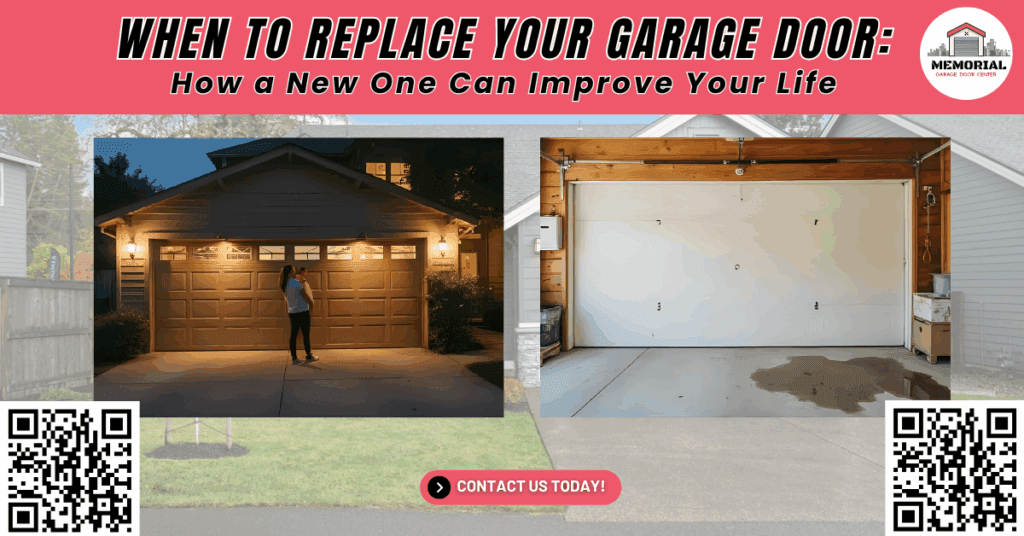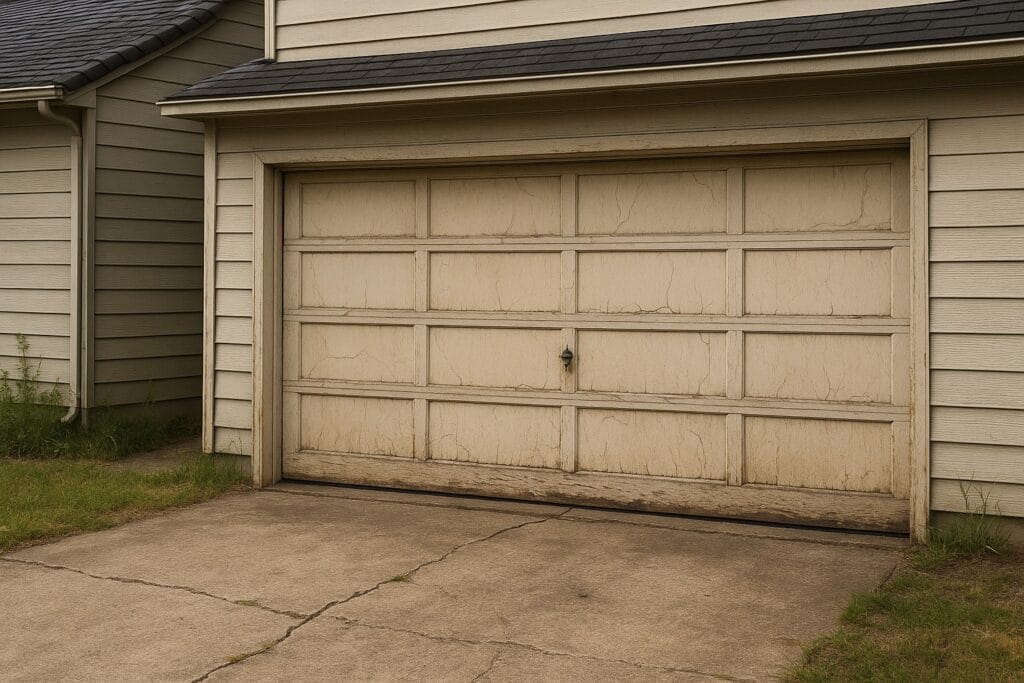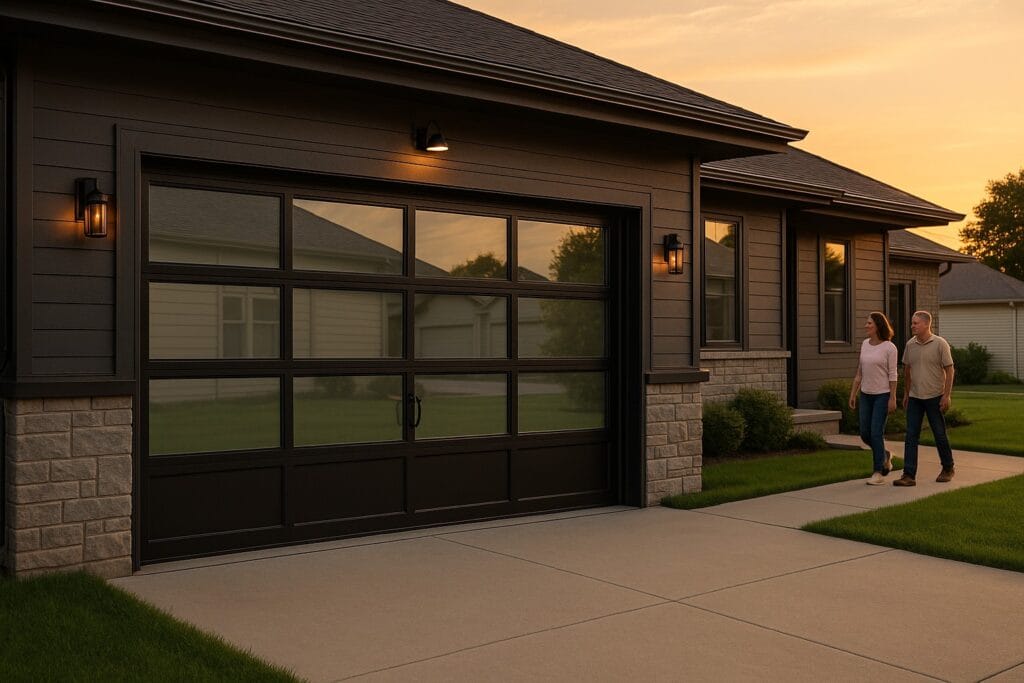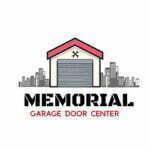When to Replace Your Garage Door: How a New One Can Improve Your Life

A Wake-Up Call in the Middle of the Night…
In the quiet neighborhood of River Oaks, Houston, a man named David O’Mara experienced something every homeowner dreads: a loud crash in the middle of the night that shook his entire house. The culprit? His old wooden garage door had finally succumbed to years of wear and tear. The garage door springs had snapped, the panels had delaminated, and the opener failed under the pressure, causing the door to slam down and trap his car inside. After a thorough inspection, our team at Memorial Garage Door Center determined that David needed a full garage door replacement. The good news? With a brand-new insulated steel door and smart opener installed, not only was the problem solved, but David’s energy bills decreased, his home became more secure, and the exterior got a stylish update.
Situations like David’s are common across Houston. According to the U.S. Department of Energy, a garage can account for up to 30% of a home’s façade and impact more than 25% of overall home energy usage when poorly insulated. With extreme heat, humidity, and the threat of hurricanes, a poorly functioning garage door in Texas isn’t just an inconvenience, it’s a liability.
If you’ve ever wondered whether it’s time to replace your garage door, this comprehensive guide is for you. As experts in garage door services, including installation, repair, maintenance, and smart technology upgrades, Memorial Garage Door Center is here to help Houston homeowners make informed decisions that improve their homes, safety, and lifestyles.
Signs It’s Time to Replace Your Garage Door
1. Your Garage Door is Over 15 Years Old
Most garage doors have a lifespan of 15 to 30 years, depending on usage and maintenance. However, in areas like Houston, where the weather is often severe, even high-end doors can start showing their age after 15 years. The materials begin to degrade: wood panels may warp or delaminate, steel doors may corrode, and even durable fiberglass or vinyl doors can become brittle from prolonged UV exposure. If you’ve had the same garage door for over a decade and it’s showing signs of fatigue, rust, noise, or sagging, it’s time to start thinking about replacement rather than repair.

Tip: If your door lacks insulation or modern safety features, it’s almost always more cost-effective to upgrade to a new garage door than to continue maintaining the old one.
2. Strange Noises Signal Trouble
All garage doors make some noise, but when those noises become louder or more erratic, it’s a sign that something’s wrong. Squealing, grinding, popping, or rumbling sounds may indicate problems with garage door springs, rollers, or the opener’s drive system. For example, a chain-drive garage door opener may rattle if not properly lubricated or aligned, while a worn belt drive may begin slipping. These problems can lead to greater mechanical failure if left unresolved.
Real-life insight: We once helped a homeowner in Spring Branch whose garage door was making strange grinding sounds. It turned out their torsion springs had weakened unevenly, putting the door off-balance. Our team replaced the springs and upgraded their opener to a modern belt-drive model, restoring quiet operation and improving performance.
3. Uneven or Sagging Appearance
If your garage door looks crooked or hangs unevenly, it’s not just an aesthetic problem; it’s a serious functional issue. Sagging can be caused by warped panels, broken cables, or uneven tension in the springs. Not only does this affect how your door opens and closes, but it also impacts safety, especially if you have a sectional garage door. These systems rely on precise alignment for the door to move smoothly along the tracks.
Pro tip: Regular inspection and balanced spring tension can prevent premature sagging, but once it sets in, a complete door replacement is often necessary to ensure smooth and secure operation.
4. Rising Energy Bills and Poor Insulation
If your garage is attached to your home, it can significantly affect your HVAC system. Older doors with poor or no insulation allow outside air to seep in, forcing your heating and cooling systems to work harder. This is especially true for garages with rooms directly above or adjacent to them. Doors with poor R-value ratings often allow extreme heat or cold to pass through, impacting the comfort and energy usage of your entire house.
Solution: Upgrading to an insulated steel, composite, or fiberglass garage door with an R-value of 10 or higher can dramatically reduce your utility bills. Look for multi-layer doors that include steel or aluminum skins over a polyurethane or polystyrene core.
5. Outdated or Unsafe Openers
Many homes built before the early 2000s still use outdated garage door openers that lack essential safety features. If your system doesn’t include auto-reverse sensors, manual release mechanisms, or rolling code technology, it may pose a hazard, especially to children and pets. Modern systems integrate smart technology, allowing you to monitor and control your garage door from your phone, receive alerts if it’s left open, and set schedules for opening and closing.
Did you know? Houston homes experience one of the highest burglary rates in the state. A smart garage door opener adds a critical layer of protection by alerting you in real-time and denying unauthorized access attempts.
How a New Garage Door Can Improve Your Life
1. Advanced Safety and Enhanced Security
A new garage door means enhanced peace of mind. Modern doors are built with stronger materials, tamper-resistant brackets, and better locking systems. When paired with smart openers, you can monitor your garage from anywhere using a mobile app. Doors equipped with auto-close, motion detection, and security cameras make it difficult for intruders to breach your home.
Example: One customer in the Heights upgraded to a steel-reinforced carriage house-style door with built-in sensors and keypad access. Their home insurance premium dropped by 10% after the installation due to the improved security.
2. Lower Utility Costs and Greater Energy Efficiency
Insulated garage doors maintain a consistent indoor temperature, which is vital in both summer and winter. Polyurethane-insulated garage doors offer the highest thermal resistance and often come with weather stripping to further reduce air leakage. If you use your garage as a laundry room, gym, or workspace, these features will make a noticeable difference in comfort.
Fun fact: The U.S. Department of Energy reports that insulating a garage door can reduce energy loss by up to 71% in uninsulated garages. Over time, this leads to substantial savings.
3. Reduced Noise and Better Daily Experience
Older doors tend to squeal, scrape, or bang during operation. A new garage door, especially one installed with a belt drive opener, provides whisper-quiet functionality. This is a major advantage if your garage is adjacent to a bedroom or living space. With noise-dampening panels and nylon rollers, modern doors enhance your home’s tranquility.
Pro tip: Always request nylon-coated steel rollers during installation. They reduce noise and last longer than traditional metal ones.
4. Dramatic Curb Appeal and Increased Property Value
A new garage door can transform the entire look of your home. Choose from thousands of design combinations, including faux wood finishes, windows, custom hardware, and modern color palettes. Stylish garage doors not only make a statement but also boost resale value.
Data point: According to the National Association of Realtors, homes with upgraded garage doors sell up to 4% faster and for 3–5% more than those with dated designs.

5. Smart Features that Make Life Easier
Modern garage door openers integrate seamlessly with smart home systems. Want to open the door with your voice? Control access from your smartwatch? Set vacation modes while traveling? These conveniences are now standard in most new systems.
Bonus Insight: Look for openers with battery backup systems to ensure your door works even during a power outage, crucial during Houston’s hurricane season.
When Repairs Aren’t Enough
Many homeowners try to patch or repaint aging doors to delay replacement. But sometimes, that’s just masking a bigger problem. Here’s when to call it quits on repairs:
- Multiple Panel Damage: Replacing more than two panels? A new door will be cheaper in the long run.
- Obsolete Hardware: Replacement parts for old systems can be hard to find or more expensive than newer alternatives.
- Poor Structural Integrity: Rotting wood, rusted tracks, or broken framing may compromise safety.
Handyman tip: If you’re spending more than 50% of the cost of a new door on annual repairs, it’s time for a full garage door replacement.
Choosing the Right New Garage Door
1. Selecting the Best Material
- Steel: Durable, low maintenance, and cost-effective. Great for all climates.
- Wood: Aesthetic appeal, but needs regular sealing. Best for custom homes or historic districts.
- Vinyl/Composite: Dent- and rust-resistant; ideal for families and high-traffic areas.
- Fiberglass: Lightweight and stylish; best for humid climates.
- Aluminum/Glass: Sleek and modern; often chosen for luxury properties or detached garages.
2. Matching the Style to Your Home
Choose from garage door styles like:
- Craftsman or Carriage House: Timeless charm, perfect for older homes.
- Contemporary/Modern: Sleek and minimalist, ideal for new construction.
- French Door Designs: Elegant and inviting, often paired with glass panels.
Custom paint finishes, hardware, and window inserts help match the garage door to the rest of your exterior, from shutters to entry doors and even your fence or gate.
3. Calculating Cost and Labor
Installation costs vary widely:
- Single Garage Doors: $1,200–$3,500
- Double Doors: $2,500–$5,500+
- Custom Installations: Up to $7,500
Labor costs depend on the complexity of the installation. Removing old doors, reinforcing openings, and installing smart systems can increase the total. However, investing in professional installation ensures long-term performance and safety.
How Can Memorial Garage Door Center Help You?
At Memorial Garage Door Center, we offer Houston homeowners the perfect blend of craftsmanship, technology, and reliability. Whether you need a brand-new garage door installation, opener upgrade, or a complete design overhaul, we’re ready to deliver.
Here’s what sets us apart:
- ✅ Free onsite consultations
- ✅ Fully licensed and insured professionals
- ✅ Emergency service and same-day appointments
- ✅ Wide range of designs and materials
- ✅ Smart technology specialists
📍 Visit us: 2417 Sabine St, Houston, TX 77007
📞 Call today: (281) 720-3113
We proudly serve Houston, The Heights, Spring Branch, Bellaire, Midtown, and all surrounding areas.
Final Thoughts
Your garage door is more than just a functional entry; it’s a key part of your home’s personality, safety, and energy efficiency. Whether you’re dealing with rising repair costs, outdated materials, or just looking for a style upgrade, investing in a new garage door is a smart decision. It enhances curb appeal, lowers your bills, protects your family, and simplifies your life through smart features and modern design.
Don’t wait for a total failure or an emergency. Take proactive steps now by reaching out to your local garage experts at Memorial Garage Door Center. We’re here to guide you through every step, from consultation to installation, with honesty, expertise, and unmatched service.
📞 Ready to improve your home? Call us today or request your free estimate online.
Frequently Asked Questions (FAQs)
1. How long does it take to replace a garage door from start to finish?
The entire process usually takes 4 to 6 hours for standard garage door replacements. Custom or oversized doors, smart opener installations, or structural adjustments may extend the time to a full day. Lead time for custom orders may be 1–3 weeks, depending on material and design.
2. Do I need a permit to replace my garage door in Houston?
Yes, in most cases, a permit is required for garage door replacements in Houston, especially if the project involves structural changes or hurricane-rated doors. A licensed installer like Memorial Garage Door Center will typically handle the permitting process for you.
3. Can I reuse my old garage door tracks and hardware with a new door?
Reusing old tracks and hardware is not recommended. New garage doors often have different specifications, and mismatched components can cause alignment and safety issues. It’s best to install a complete, compatible system for long-term reliability.
4. How can I maintain my new garage door to extend its lifespan?
To extend the life of your new garage door, perform seasonal maintenance like lubricating moving parts, tightening hardware, and checking the balance. Clean the door exterior regularly and inspect weather seals for wear. Schedule a professional inspection at least once a year to ensure everything operates smoothly.
